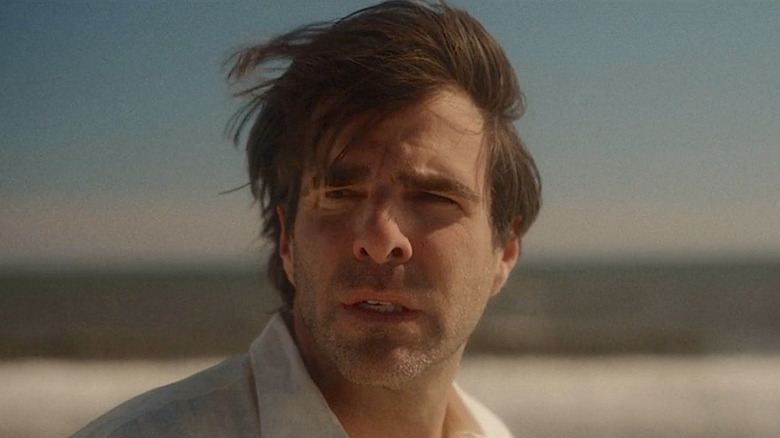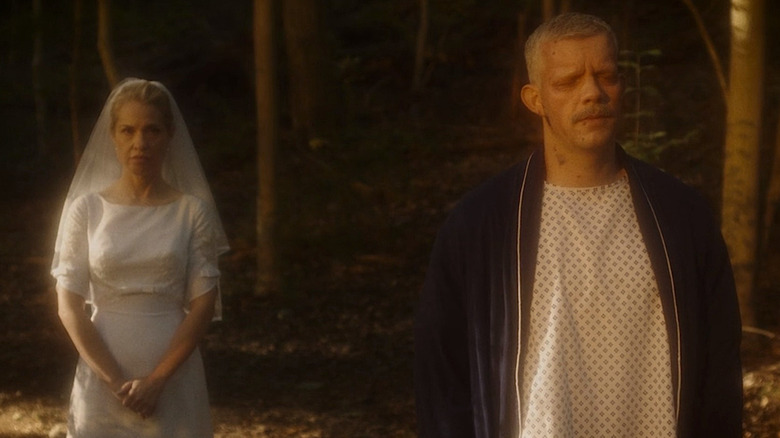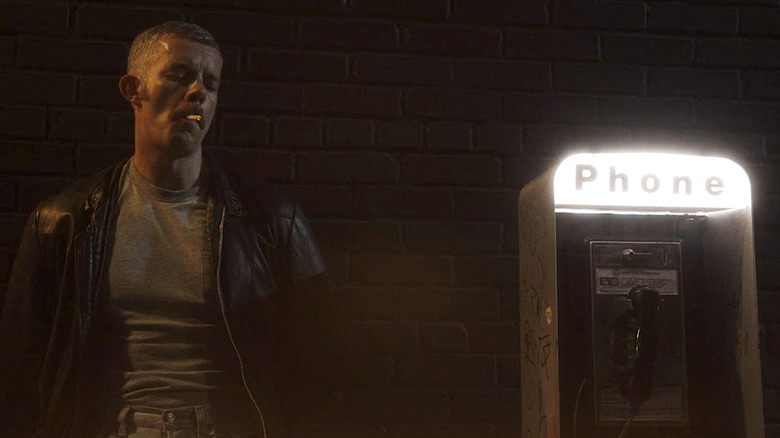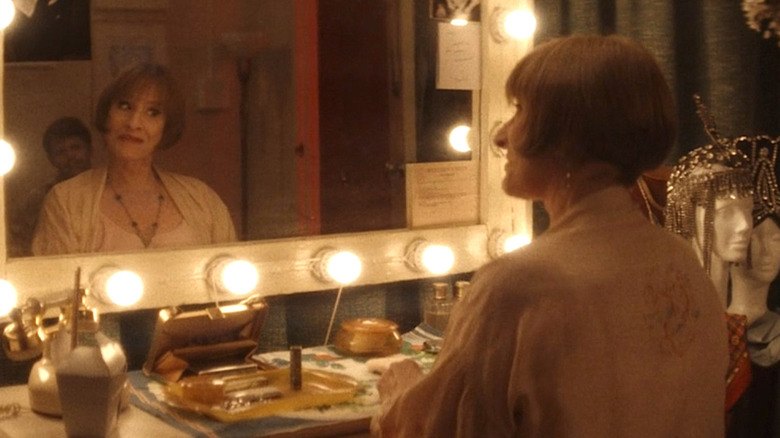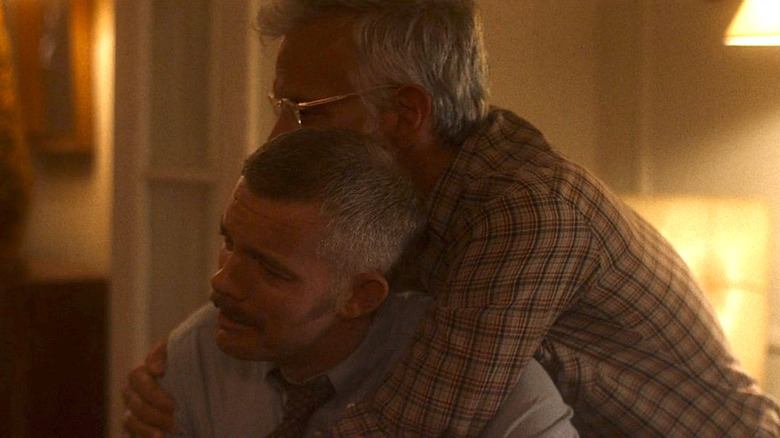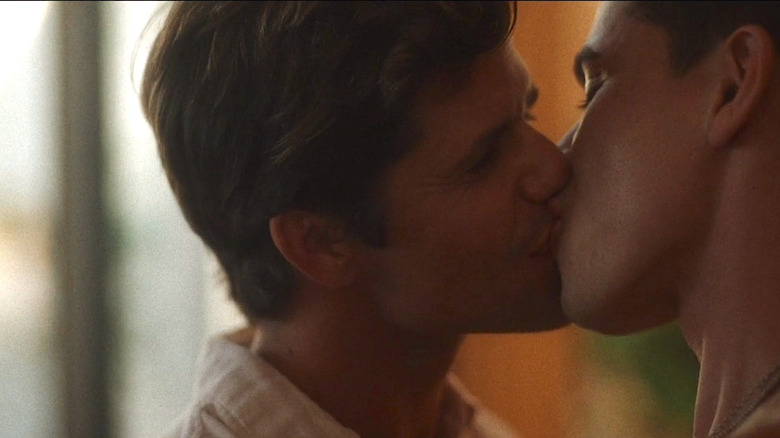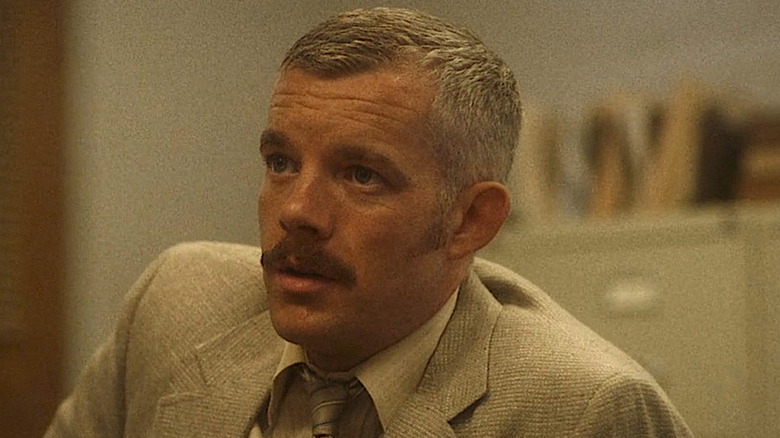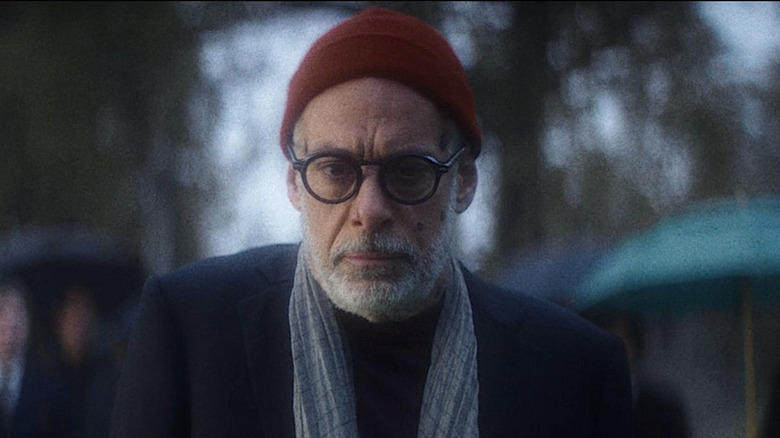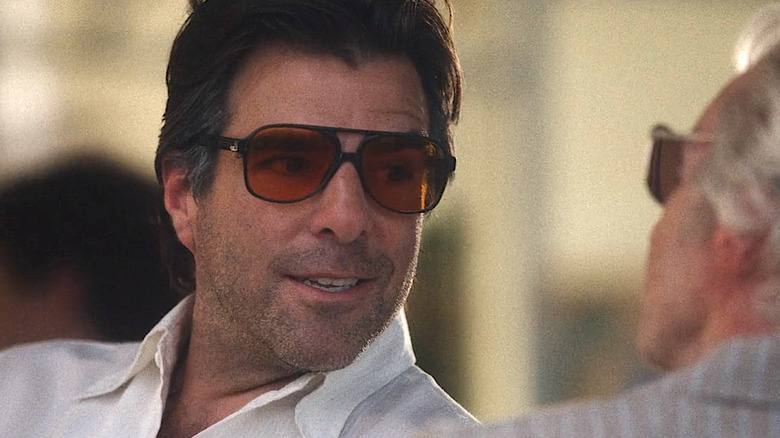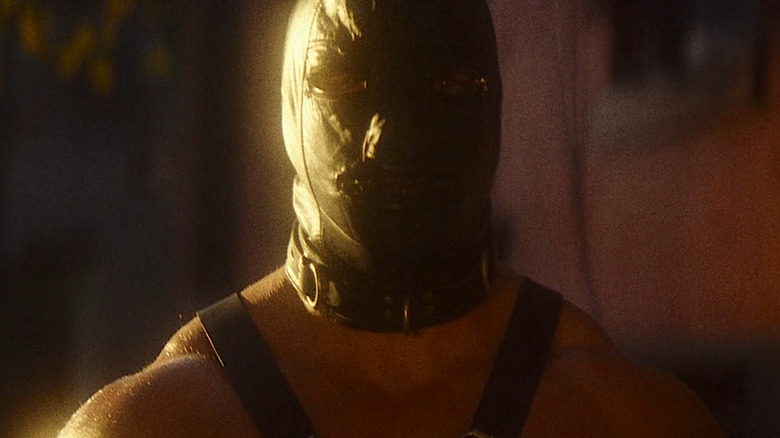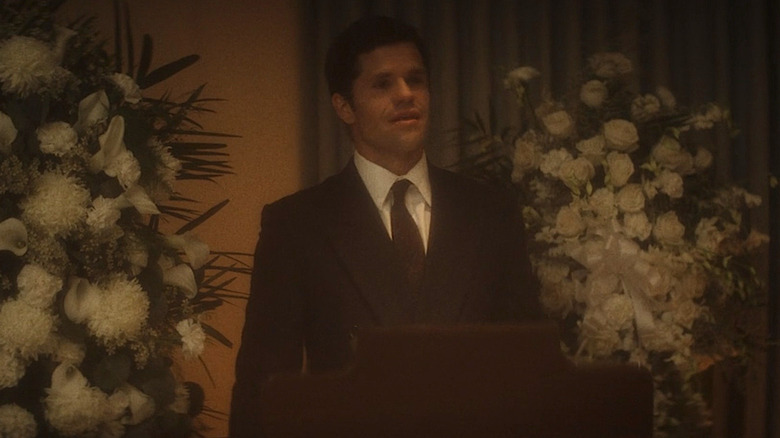The Ending Of American Horror Story: NYC Explained
"American Horror Story: NYC" draws to a powerful, painful, and complicated close. The horror anthology series has never been one to conform to anyone's expectations, but this season is especially original. Multiple serial killers stalk the hazy streets and clubs of 1980s New York City this time around, but there's an even bigger bad guy out for blood: the AIDS virus. After a tumultuous slate of episodes, this season arrives at an ending that underscores just how different it truly is.
Of course, this season also features characters sawing off their own hands in old warehouses, deer ticks used as agents of biological warfare, and villains indulging in gallows humor over shallow graves. Gore and goofy plot logic are hallmarks of "American Horror Story," no matter how serious a season's subject matter may be, and "American Horror Story: NYC" more than meets its quota of disturbing moments. Still, there's much more at play in this season of "American Horror Story" than there is in prior storylines. The two-part season finale unravels some of the story's knottier plotting, while also invoking everything from "Angels in America" to "A Christmas Carol." It all concludes with a literal trip down memory lane, plus a powerful lament for a community forced to confront both a deadly plague and the world's indifference. It is, in short, a lot — and we're here to break it down for you. This is the ending of "American Horror Story: NYC," explained.
Nothing but shattered dreams
The first eight episodes of "American Horror Story: NYC" focus more on mystery and crime than any previous season of the show. Episode 8 "Fire Island," is a particularly action-packed example. The Mai Tai Killer is done and dusted, but Big Daddy and Sam (Zachary Quinto) are up to no good. It all culminates in what might be the end of Big Daddy, and the heartbreaking demise of Theo Graves (Isaac Powell). The final moments of the episode see the show enter a dark dreamscape, from which it never fully emerges.
Sam leads Henry to the "Meat Rack," where a drugged Theo is tied to a tree. The territory takes on a surreal, soft-focus, blue-hued look. Later, sparkling deer-boys untie Theo and guide him into the bright light of death. The season's final episodes, "Requiem 1981/1987 Part One" and "Requiem 1981/187 Part Two," proceed to dispense with anything resembling dramatic tension, instead closing the show with trippy dream sequences that bring the Ghost of Christmas Future from "A Christmas Carol" to mind. These dreams are far from sweet. No one gets a happy ending here, even if they get a living one, and it's all fairly elliptical. But what the final episodes lack in narrative drive, they make up for in their steadfast commitment to portraying the full devastation of the AIDS crisis and the stigmatization and misinformation it spawned.
The legacy of Cruising
"American Horror Story: NYC" finishes with a dream-sequence dirge, but it starts as a sexy, scary crime thriller. Audiences are kept guessing as to who (or what) is killing Greenwich Village's gay men, and if Patrick Read will figure out the answer before the murderer sets his sights on him. As Patrick's actor, Russell Tovey, recounted to Variety, series co-creator Ryan Murphy told him, "'I've got a great role for you. It's going to be based on 'Cruising' ... It's kind of like the Al Pacino role.'" As savvy viewers might know already, this is a very intriguing comparison that highlights one of the finale's most important threads.
"Cruising" is a 1980 film starring Al Pacino as a straight detective who goes undercover as a gay man. The film's debut was met with controversy: As The New York Times reported, it even inspired a march through Greenwich Village. Gay rights activist Ethan Geto spoke for many when he decried the film's portrayal of gay men and gay culture as dangerously demeaning.
"American Horror Story: NYC" tackles this legacy in a complex way. The fact that it isn't written from a straight perspective makes a big difference: Patrick is a gay man struggling with shame, rather than an undercover straight man. It all comes crashing down on him in the finale, which takes the season far from its more straightforward beginnings. What results is a fascinating continuation and reversal of the legacy left behind by "Cruising."
Vitality without shame
"American Horror Story: NYC" starts as a sleek thriller and ends as an elegy for the AIDS crisis. Despair ties both halves of the season together, and constitutes a main thread of the final two episodes. It's sorrowful and rage-inducing to see Gino Barelli (Joe Mantello) write, protest, caretake, and ultimately watch his loved ones die from AIDS. That he does so in the face of poor conditions and near-total public indifference makes things even more intense.
Kathy Pizazz (Patti LuPone), the bathhouse chanteuse-slash-tarot-shop-proprietor, laments to Adam Carpenter (Charlie Carver) that the time has come to close up shop. "The end of an era. All that music. All that love. Vitality without shame. But it's gone now," she says. This sentiment is in contrast to the way the series usually paints these spaces. This is, after all, a horror story, and though people have fun in these clubs and bars, they also suffer and die. But in this moment, "American Horror Story: NYC" chooses to frame them as wonderful places brimming with joy. Despite the utter hopelessness and rage of the season's ending, Kathy insists Adam maintain hope and remember to live as long as he's able.
Patrick and Gino
"American Horror Story: NYC" is full of sinister acts, but it also explores heart-rending passion and true love. Take Gino and Patrick. Despite their hardships, their bond lasts all the way through the devastation of Patrick's final days. Together, they move through shame to the safety of their love. This is at the core of the season as a whole, and the finale specifically.
One of the most powerful moments of "American Horror Story: NYC" happens when Gino confronts Patrick about sleeping with other men and being into the leather scene, which Patrick previously claimed ignorance of. Patrick admits his cheating is compulsive. He promises to stop, but Gino says it isn't the cheating that bothers him — it's the shame. "You only tell the truth when you're about to get caught," he says. "That's shame." Gino's words hit Patrick — and the audience — square in the chest.
For all his strength and swagger, Patrick needs to be challenged and comforted by Gino. Patrick's growth, in turn, forces Gino to consider a truly wild possibility: hope. When Gino comforts Patrick after an attempt on his life, he insists they're safe. "We'll never be safe," Patrick replies. There's a lot of sad truth to this statement, but it's not entirely accurate. In this moment, these two find solace in each other, and that means everything. In fact, in the world of "American Horror Story," it's basically a miracle.
Adam and Theo
The relationship between Adam and Theo Graves is one of the most poignant elements of "American Horror Story: NYC." It's sweet, sexy, and healthy — and because this is "American Horror Story," it's not long for this world. Adam and Theo are something of an odd couple. The former is a square (mostly) satisfied with nights in, until he dedicates his hours to searching for lost friends and advocating for his community. The latter is creative, drawn to dark energy, and finds beauty in surprising places. Theo is also coming off of Sam's manipulative machinations, which makes the steady energy between him and Adam especially welcome.
But then, Adam and Theo are cruelly parted. Adam, who has lost countless friends to (possibly) the Mai Tai Killer and (definitely) Big Daddy, now loses Theo to Sam, the biggest villain on the show who isn't an allegory for illness. Theo's one-two punch of a demise via disease, drugs, and possible sexual assault is the traumatic cherry on top of an already stuffed-with-trauma cake. The final episodes feature Theo in the role of Sam's Afterlife Guide, which serves as a brutal reminder to the audience that the good guys definitely don't always win.
The fate of Patrick Read
Whether you think Patrick Read is toxic trash or a guy just doing his best, one thing is for sure: No one deserves such a rough death. For all his brutality and bluster, Patrick wants to stop the bad guys — even when he turns out to be one of them. Thanks to Gino's good influence, Patrick goes from being a closeted cop to an out gay man. He still struggles with shame and silence, but hey, it's progress!
The fact that Patrick takes the trophy for the season's Most Improved Player makes his death especially gutting. What rubs even more salt in the wound? His Afterlife Guide is Barbara (Leslie Grossman), his ex-wife, who would have preferred Patrick to continue living a lie. She walks him through the worst moments of his life. This begs a simple question: why?
"Requiem 1981/1987 Part One" is jam-packed with thesis statements and dream sequences. Important thematic messages come so thick and fast, it feels like they're shot out of confetti cannons in the middle of Burning Man. This doesn't diminish the power of Russell Tovey's performance, but it does make the final phase of his arc fascinatingly ambiguous. Are we to believe Patrick deserved his suffering? Was he helpless to break the cycle of pain? Did his own shame condemn him to spend the afterlife reliving the pain he caused and the pain the hateful world caused him? It's unclear — and that might be the point.
Gino's relentless love
Gino Barelli is one of the good guys, and boy, is he mad about it. He's mad about everything, actually, and with good reason. Not only is AIDS devastating his community, Gino is almost murdered about a hundred times. The man fights with the Marines, gets captured and tortured by the Mai Tai Killer (twice), gets tied up and shoved into a drawer at the morgue, and gets a night of drinks and jazz at Fire Island ruined by Big Daddy.
But Gino just won't die — for a while, anyway. He has too much to do. His passion for progress is most vividly represented by his work on The Downtown Native and his tireless committment to his own community. Gino appears in both parts of "Requiem 1981/1987," and both appearances are heartbreaking examples of his tenacity in the face of relentless ignorance and cruelty. They're also proof of his deep and unending love. His tenderness towards Patrick in his poor excuse for a hospital room is particularly vivid: He's not at his typewriter or a protest site, but Gino's care is just as passionate and committed. This man's home fires are fueled by love and rage, and he keeps both burning until the bitter end.
Sam's other side
Sam is the embodiment of self-centeredness and a horrifying example of just how reckless and ruthless people can be when they only care about what they want. Though he's not technically a serial killer, Sam does the dirtiest deeds on all of "American Horror Story: NYC." He also looks great in anything he does or doesn't wear, and can toss off effortlessly brilliant bon mots. "I'm really sorry that I forgot my violin for this perfect little moment," he quips, "but we do have a body to dispose of, so do you want to pitch in?" In other words, Sam is a capital-V Villain. The finale plays with this fact is fascinatingly disorienting ways.
"Requiem 1981/1987 Part One" is largely dedicated to Theo's spirit guiding Sam through the terrible acts he committed in life, as well as a very creepy interlude with Sam's father, who caused him significant pain. This episode is disorienting, due to its dreamlike nature. Such an approach, paired with a deeper look into Sam's psyche — right after he causes Theo's heartbreaking death, no less — packs a significant punch.
While this might seem like a jarring switch of storytelling and perspective, the sheer amount of time the audience is forced to spend in Sam's nightmare ends up working. We see a different side of Sam mere moments before he makes out with his own personal Big Daddy and catches a ride to the flip side. Does it redeem him? Not really. But it forces us into a new point of view.
Whitely, Big Daddy, and the skeleton crew
If "American Horror Story: NYC" is successful at anything, it's making audiences understand that great pain, shame, and desire drive drastic actions. Mr. Whitely's (Jeff Hiller) desire to build a Frankenstein's monster out of gay men's body parts in order to protect gay men is deranged, but it makes some sliver of sense when you consider just how bigoted, ignorant, and dismissive the public was during the early days of the AIDS crisis. Whitely thinks he's protecting the greater good the only way his twisted mind knows how: by fighting death with death.
The final episodes of "American Horror Story: NYC" are indeed a festival of death — and not just the slasher kind. The slow, silent march into oblivion is evidenced by countless skull-masked men dropping into an open grave, and Gino living out his final days under Big Daddy's impenetrable, leather-clad gaze. While this imagery is devastating, poetic, and nearly overwhelming, it might also feel a bit confused to some viewers. Why, they might wonder, is the specter of death a leather daddy? What's the real-world meaning of this complicated symbol?
The leather scene is important to the community captured in "American Horror Story: NYC." It's also full of pain. Making Big Daddy the avatar of the AIDS crisis can be seen as underscoring many points: He is a terrible perversion of community joy, a symbol of the public's callousness and cruelty towards gay men, and a complicated mingling of anger and despair. Big Daddy's ending points towards deeper shame still being teased out and resolved in the aftermath of the AIDS crisis. It's up to interpretation, but one thing is clear: Big Daddy is key to the ending's meaning.
Adam's ray of hope
Adam Carpenter is the closest thing "American Horror Story" has to a beacon of hope, so it's a good thing he's the last man standing. Yet Adam still endures unspeakable heartbreak. He loses his lover, many friends, and experiences the trauma of the Big Daddy and Mai Tai Killer attacks. Undaunted, Adam moves through his losses. This momentum is key to the season's ending.
If Gino creates his own sentinel persona using love, loss, and rage as fuel, Adam builds his protector persona out of a dedication to and deep understanding of his community. Adam does his homework, whether he's tracking a killer, gaining understanding of the disease from Hannah's audio notes, or (we can infer) coming up with catchy slogans to encourage his community to practice safe sex. He may look like a boy scout, but by the time the finale rolls around, we know he's lived through hell. Adam's concerns about AIDS are consistently dismissed, yet he still fights the good public health fight. It doesn't stop him, and it also doesn't break him.
Much lip service is paid to the importance of transcending cycles of pain and protecting one's community in the final episodes of "American Horror Story: NYC." Adam is shown doing just this. By the time Adam stands to speak at Gino's funeral, we see him open his mouth, take a breath — and that's it. We don't need more, because his actions speak for themselves. We already know that whatever Adam has to say will provide his community with a much-needed bit of light in the unrelenting dark.
